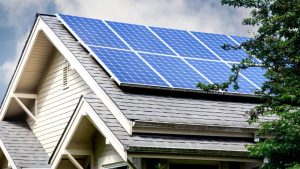Hundreds of companies manufacture solar panels. Many solar panels fall into three categories: monocrystalline, polycrystalline (also known as multi-crystalline), or thin-film. All three types of solar panel categories differ in how they are made, and in their appearance, performance, and cost.
The Major Types of Solar Panels
Monocrystalline, polycrystalline and thin-film solar panels all have advantages and disadvantages. Before you decide which solar panels are best for your home, consider these properties:
Monocrystalline Panels
The first type of solar panel is Monocrystalline. Monocrystalline solar panels demonstrate high efficiency and performance. Out of all the solar panel types, monocrystalline panels can convert the highest amount of electricity into solar electricity. The cells are made out of silicon wafers and are cut from a single pure crystal of silicon. The wafers are arranged in rows and columns to form a rectangle. They are then covered by a glass sheet and framed together.
The primary disadvantage with Monocrystalline panels is their cost. Because their manufacturing process involves more work, these panels are more costly. The cost of making a single pure crystal is time consuming and silicon feedstock is very expensive.
Monocrystalline solar panels are also more aesthetically pleasing. Cells in these panels appear black. This is due to the way the light interacts with the pure silicon crystals. Additionally, the back sheet of the panel is usually black, silver or white and the metal frames are typically white or silver.
Polycrystalline Panels
The next solar panel type is a polycrystalline panel. These panels are less costly versus the monocrystalline panels. However, they are also perform with lower efficiency than the monocrystalline panels. Both polycrystalline and monocrystalline panels have a similar manufacturing process. The only difference is while monocrystalline panels are cut from single pure crystals, polycrystalline panels are composed from fragments of crystals. The fragments are melted together in a mold before being cut into wafers.
The lower cost is due to their manufacturing process being far less complex.
Although they have a similar make-up, polycrystalline panels look different than their counterpart. These panels tend to have a bluish tint to them. Light reflects off the fragmented silicon differently vs. the pure silicon crystals in the monocrystalline panels.
Thin-film Panels
Lastly, we have the thin-filmed solar panel. Thin-filmed panels are portable, flexible, and lightweight. Thin-filmed panels are made from a variety of materials. Despite which type, the manufacturing process is similar to monocrystalline and polycrystalline panels. However, these panels are not made from solid silicon wafers. Instead, these panels are made of non-crystalline wafers on top of glass, plastic or metal.
A popular thin-film panel is the Copper Indium Gallium Selenide panel. All four elements of the panel are between layers of glass, plastic, aluminum, or steel. Further the electrodes are placed in the front and the back of the material to capture electrical currents.
Like monocrystalline panels, thin-filmed panels are also very aesthetically pleasing. The technology is very thin and low profile compared to its counterparts. This is because the cells within the panel are 350 times smaller than the wafers in monocrystalline and polycrystalline panels. As for color, the panels come in blue or black tints. Thin-filmed panels have the lowest cost compared to both monocrystalline and polycrystalline panels. Because they are lighter weight and maneuverable, they are less labor intensive as a whole.
—
Solar panels have significantly increased in popularity throughout the United States. There are many solar panel types to choose from that need to appeal to your style and align with your financials. Every situation is different. Surf Clean Energy can guide you on the solar panel type this is right for you and your home. They are dedicated to educating homeowners about their local energy situation and assessing individual homeowner needs. Visit the Surf Clean Energy website to schedule an appointment.
You may also like to read more about Solar Batteries.




